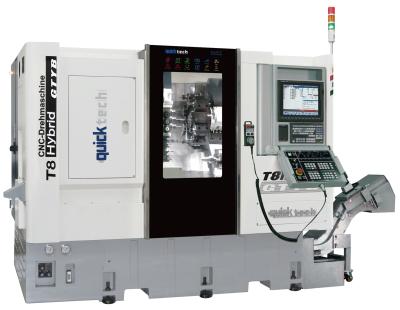
The T8 Hybrid 9-axis twin-spindle mill/turn center from Quicktech combines a 3-axis power turret and a 360˚ B-axis with a sub-spindle that features a 4-axis gang slide to enable complete machining of complex parts with a capacity of 38 tools. Quicktech machines are distributed in North America exclusively by Absolute Machine Tools Inc.
The T8 Hybrid has two turning spindles and two live milling spindles. The 15-hp main spindle is available with either an 8", 3-jaw chuck providing 65mm (2.6") bar capacity, or a 60mm collet chuck that accommodates 60mm (2.4") bar stock. The 42mm (1.68") collet chuck of the subspindle accepts 32mm (1.28") bars. Both main and subspindles feature full continuous C-axes and are synchronized for fast, accurate part transfer. The machine’s Flexible Duo System allows two programs to be run simultaneously, reducing cycle time by up 45 percent, according to the company. Maximum turning length for the main spindle is 345mm (13.8") and maximum turning length for the subspindle is 330mm (13.2").
The main spindle has a rigid 12-station, 3-axis BMT-55 live turret with a 5-hp spindle motor and 80mm of true linear Y-axis travel. The turret features fast servomotor indexing and rigid hydraulic clamping, and all 12 turret stations can be live. The subspindle’s 4-axis gang tooling system operates in linear X-,Y-, and Z-axes plus a rotary 360˚ B-axis. The sub tool post features five OD turning tools, nine ID turning tools and 12 live tools, powered by a 2-hp spindle motor and mounted in a continuous 360˚ B-axis. Rigid tapping is standard in both the turret and B-axis.
The T8 Hybrid is reportedly engineered for precision and durability. The machine frame and all major components are heavy Meehanite cast iron. The turret Y-axis is a true linear axis, perpendicular to the X-axis for maximum precision. Large 35mm Hiwin roller-type linear guideways in all linear axes provide stability and permit heavier machining. Substantial 32mm ballscrews are double anchored, pretensioned and direct coupled to the machine’s servo motors.
A matched Mitsubishi CNC system consists of a Mitsubishi M830S control with a 275mm (15") LCD and Mitsubishi servo motors and amplifiers for top reliability and performance. A FANUC OiT-F control with a 275mm (15") LCD and matched FANUC motors and drives is also available. Standard machine features include a bar feeder interface, parts conveyor and catcher, chip conveyor, collet chucks and a 400-psi coolant pump.
Steve Ortner, president and owner of Absolute Machine Tools, said, “The T8 Hybrid machines represent a blend of machining technologies that enables users to enable users to maximize both productivity and efficiency.”
Contact Details
Related Glossary Terms
- chuck
chuck
Workholding device that affixes to a mill, lathe or drill-press spindle. It holds a tool or workpiece by one end, allowing it to be rotated. May also be fitted to the machine table to hold a workpiece. Two or more adjustable jaws actually hold the tool or part. May be actuated manually, pneumatically, hydraulically or electrically. See collet.
- collet
collet
Flexible-sided device that secures a tool or workpiece. Similar in function to a chuck, but can accommodate only a narrow size range. Typically provides greater gripping force and precision than a chuck. See chuck.
- computer numerical control ( CNC)
computer numerical control ( CNC)
Microprocessor-based controller dedicated to a machine tool that permits the creation or modification of parts. Programmed numerical control activates the machine’s servos and spindle drives and controls the various machining operations. See DNC, direct numerical control; NC, numerical control.
- coolant
coolant
Fluid that reduces temperature buildup at the tool/workpiece interface during machining. Normally takes the form of a liquid such as soluble or chemical mixtures (semisynthetic, synthetic) but can be pressurized air or other gas. Because of water’s ability to absorb great quantities of heat, it is widely used as a coolant and vehicle for various cutting compounds, with the water-to-compound ratio varying with the machining task. See cutting fluid; semisynthetic cutting fluid; soluble-oil cutting fluid; synthetic cutting fluid.
- gang cutting ( milling)
gang cutting ( milling)
Machining with several cutters mounted on a single arbor, generally for simultaneous cutting.
- inner diameter ( ID)
inner diameter ( ID)
Dimension that defines the inside diameter of a cavity or hole. See OD, outer diameter.
- milling
milling
Machining operation in which metal or other material is removed by applying power to a rotating cutter. In vertical milling, the cutting tool is mounted vertically on the spindle. In horizontal milling, the cutting tool is mounted horizontally, either directly on the spindle or on an arbor. Horizontal milling is further broken down into conventional milling, where the cutter rotates opposite the direction of feed, or “up” into the workpiece; and climb milling, where the cutter rotates in the direction of feed, or “down” into the workpiece. Milling operations include plane or surface milling, endmilling, facemilling, angle milling, form milling and profiling.
- outer diameter ( OD)
outer diameter ( OD)
Dimension that defines the exterior diameter of a cylindrical or round part. See ID, inner diameter.
- tapping
tapping
Machining operation in which a tap, with teeth on its periphery, cuts internal threads in a predrilled hole having a smaller diameter than the tap diameter. Threads are formed by a combined rotary and axial-relative motion between tap and workpiece. See tap.
- turning
turning
Workpiece is held in a chuck, mounted on a face plate or secured between centers and rotated while a cutting tool, normally a single-point tool, is fed into it along its periphery or across its end or face. Takes the form of straight turning (cutting along the periphery of the workpiece); taper turning (creating a taper); step turning (turning different-size diameters on the same work); chamfering (beveling an edge or shoulder); facing (cutting on an end); turning threads (usually external but can be internal); roughing (high-volume metal removal); and finishing (final light cuts). Performed on lathes, turning centers, chucking machines, automatic screw machines and similar machines.

